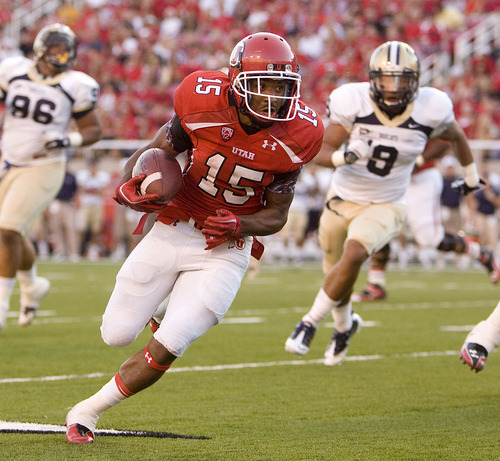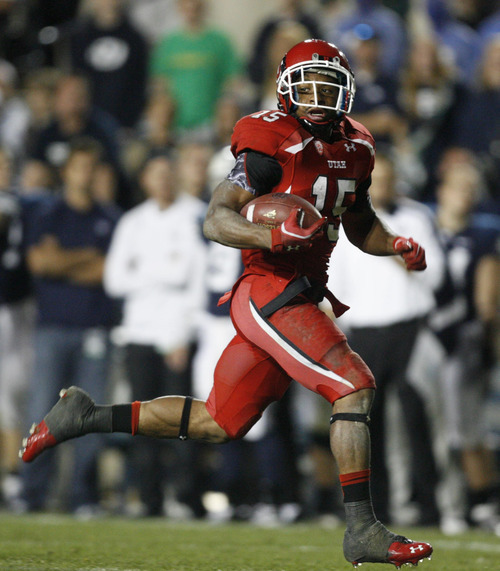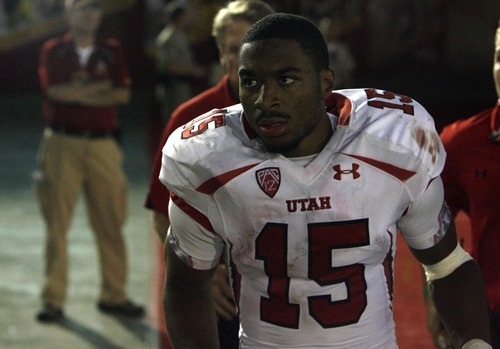This is an archived article that was published on sltrib.com in 2011, and information in the article may be outdated. It is provided only for personal research purposes and may not be reprinted.
Jamal Anderson remembers all the buildup and hype Marshall Faulk received before Faulk and his San Diego State teammates played the Utes here in Salt Lake City in 1993.
"Coach Mac [Ron McBride] came and told me, 'For us to win, you've got to be better than him,' " Anderson said. "I told him, 'No problem Coach, just give me the ball.' "
The Utes did just that and Anderson proved to be the better back that day, rushing 23 times for 156 yards and three touchdowns as the Utes beat the Aztecs 45-41. Faulk had 22 carries for 141 yards and a touchdown.
"He came in with all this stature and talk, and I had to take the challenge to prove I was just as good," said Anderson, who went on to an NFL career.
It seems it has always been that way for Utah's running backs. They're an often overlooked, under-hyped bunch who, at the end of the day, prove to be just as good or even better than the more celebrated running backs of their opponents.
From Anderson to Chris Fuamatu-Ma'afala to Mike Anderson to Brandon Warfield to Matt Asiata and Eddie Wide, the Utes have a long history of taking unheralded athletes and turning them into ground-churning, yard-eating backs.
Could John White be the next? It might be too early to tell, given he has played in just three games for the Utes, but he is near the top of the Pac-12 leaderboard, averaging 126.7 yards a game. Only Oregon's LaMichael James is averaging more at 153.3.
Given Utah's successful history at the running back position, it wouldn't be a surprise if White can keep his average high, even as Utah's schedule gets more challenging, starting with Saturday's game against Washington.
White is unfamiliar with Utah's long history of successful backs — he's too busy preparing for Utah's future opponents to spend time studying the past. But he hopes to carry on the tradition so the Utes are successful.
"I've never cared about stats," he said. "I just want us to win."
What is remarkable about Utah's successful rushing run is much of it came before the Utes had much of a national reputation. Landing blue-chip backs was out of the question, yet the Utes managed to find diamonds in the rough such as Dameon Hunter, Quinton Ganther and Eddie Wide.
Utah running backs coach Dave Schramm said the Utes don't have one particular kind of back or style of player they recruit.
"We look for the guys who work hard and want to make themselves better," he said. "It's not a cookie-cutter deal, where you find a certain type of guy and plug him in. From Quinton to Darrell Mack and Eddie and Matt [Asiata], they've all been a little different, but they all worked hard. It's what you do when you get here that matters."
There are other elements that have helped the Utes be successful. Utah isn't entrenched in using one back if it is more effective with two. Most recently, Wide and Asiata formed a good and effective combo as they shared carries.
This year, the Utes hope to get around 15 to 18 carries a game from White and have others supplement the run game.
"In today's game, you've got to have two backs who can play," Schramm said. "The carries may not be split exactly, but you have to have two who can play because you are going to get beat up and pounded, especially in this league."
Patience also matters when developing a run game and the Utes have shown plenty of it, particularly under coach Kyle Whittingham, a conservative, defensive-minded coach who believes everything starts with the run game.
"You can't give up on the run game," Whittingham said. "You saw that at the beginning of the second half [of the BYU game]. You have to commit to it and not give up on it too soon."
The other major but often overlooked factor that has helped the run game is the practice hours logged against Utah's defense. Utah's run defense historically has been as stingy as Utah's run offense has been successful.
Schramm is convinced there is a connection between the two.
"Going against our defense, these guys have to work hard to break tackles," he said. "Every player has to decide if they want to create that collision or be the guy getting hit, because if you're that guy, you won't last long."
White said going against Utah's defense was like nothing else he had experienced.
"It's ridiculous," he said. "They're good, but it makes me work harder, which makes everything else seem easier."
Sharpened by going against their teammates, Utah's running backs have found success against their opponents. Granted many of those opponents were WAC or MWC teams. Playing in the Pac-12 represents a new level of challenge.
Regardless, both White and Anderson are fully confident the Utes will keep the running game tradition alive.
"We're always proving ourselves," Anderson said. "I remember a game in 2000 when I was starting [for the Atlanta Falcons] and we were playing Denver. Who was the starting back for them? Mike Anderson. That is something USC had or Miami had and Utah had it, too. Mike and I were like, 'This is cool.' " —
Pac-12's top rushers
Player, School Carries Yds Avg/Gm
1. LaMichael James, Oregon 65 613 153.3
2. John White, Utah 61 380 126.7
3. Chris Polk, Washington 87 422 105.5
4. Marc Tyler, USC 61 303 101.0
5. Stepfan Taylor, Stanford 54 289 96.3 —
Utah's top rushers
Per game average:
137.0 • Carl Monroe, 1982
126.91 • Dameon Hunter, 2001
122.75 • Chris Fuamatu-Ma'afala, 1996
106.64 • Mike Anderson, 1998
102.45 • Del Rodgers, 1981
102.11 • Brandon Warfield, 2002
101.81 • Quinton Ganther, 2005
101.8 • Eddie Lewis, 1985
100.33 • Darrell Mack, 2007 —
Washington at Utah
P Saturday, 5 p.m.
TV • ROOT







